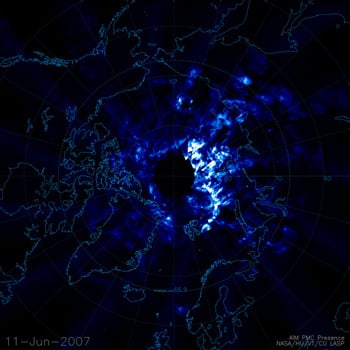
Noctilucent clouds, are tenuous cloud-like phenomena that are the "ragged-edge" of a much brighter and pervasive polar cloud layer called polar mesospheric clouds in the upper atmosphere, visible in a deep twilight. They are made of crystals of water ice. The name means roughly night shining in Latin. They are most commonly observed in the summer months at latitudes between 50° and 70° north and south of the equator.
They are the highest clouds in the Earth's atmosphere, located in the mesosphere at altitudes of around 76 to 85 kilometers (47 to 53 mi). They are normally too faint to be seen, and are visible only when illuminated by sunlight from below the horizon while the lower layers of the atmosphere are in the Earth's shadow. Noctilucent clouds are not fully understood and are a recently discovered meteorological phenomenon; there is no evidence that they were observed before 1885.
Noctilucent clouds can form only under very restrictive conditions; their occurrence can be used as a sensitive guide to changes in the upper atmosphere. Since their discovery the occurrence of noctilucent clouds has been increasing in frequency, brightness and extent.
Read more...They are the highest clouds in the Earth's atmosphere, located in the mesosphere at altitudes of around 76 to 85 kilometers (47 to 53 mi). They are normally too faint to be seen, and are visible only when illuminated by sunlight from below the horizon while the lower layers of the atmosphere are in the Earth's shadow. Noctilucent clouds are not fully understood and are a recently discovered meteorological phenomenon; there is no evidence that they were observed before 1885.
Noctilucent clouds can form only under very restrictive conditions; their occurrence can be used as a sensitive guide to changes in the upper atmosphere. Since their discovery the occurrence of noctilucent clouds has been increasing in frequency, brightness and extent.
[And from New Scientist...]
Mysterious night-shining clouds may peak this year

[...]
Although the average number of noctilucent clouds has been increasing in recent decades, their abundance also seems to rise and fall with the sun's 11-year cycle of activity. The clouds thrive when the sun is quiet and spews less ultraviolet radiation, which can destroy water needed to form the clouds and can keep temperatures too high for ice particles to form.
Because the sun has been abnormally quiet in recent years, noctilucent clouds could be especially bright and numerous this summer in the Northern hemisphere. "We expect this year to be a bigger year because of lower solar activity," says Scott Bailey of Virginia Tech in Blacksburg, VA and a lead scientist for NASA's Aeronomy of Ice in the Mesosphere (AIM) spacecraft, which launched in 2007 to study the clouds. The clouds may be about twice as abundant this year as they are when the sun is at the peak of its activity, he says.
[... and lastly, from The Register]
Scientists seek noctilucent cloud enlightenment
More night-shining expected in 2009, but why?

[...]
Back in 2007, AIM principal investigator James Russell III of Hampton University suggested the increased frequency of Polar Mesospheric Clouds (PMCs, as they're known when viewed from space - see pic above) might be due to "a connection with global changes in the lower atmosphere, and could be an early warning that our environment is being altered".
He said: "It is clear that PMCs are changing, a sign that a distant and rarified part of our atmosphere is being altered, and we do not understand how, why, or what it means."
Read more...

[...]
Back in 2007, AIM principal investigator James Russell III of Hampton University suggested the increased frequency of Polar Mesospheric Clouds (PMCs, as they're known when viewed from space - see pic above) might be due to "a connection with global changes in the lower atmosphere, and could be an early warning that our environment is being altered".
He said: "It is clear that PMCs are changing, a sign that a distant and rarified part of our atmosphere is being altered, and we do not understand how, why, or what it means."






.png)





No comments:
Post a Comment